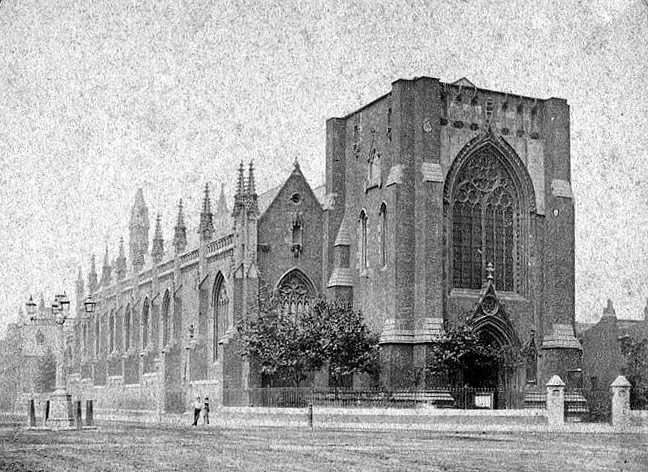You’d probably not realise it at first glance, but the modern-looking church in Southwark was actually designed by the king of the gothic revival, Augustus Pugin.
St George’s church was built in 1848, to a design by Augustus Pugin, to serve the growing Irish population in London, and Pugin was the first person to get married in the church, to his third wife Jane later that same year. The church he designed looked a little odd, as the steeple was never completed, so they ended up with a large squat square box in front of a more conventional gothic revival church nave.
In September 1850, Pope Pius IX recreated the Roman Catholic diocesan hierarchy in England, which had been extinguished with the death of the last Marian bishop in the reign of Elizabeth I. This allowed St George’s church to be elevated to St George’s Cathedral, the first Catholic Cathedral in London since the time of the reformation.
What’s there today looks the same, but different.
All the gothic has gone, leaving a much more modern appearance, and for that, we can blame a WW2 bomb that hit the Cathedral on the night of 16th April 1941 and gutted the entire interior of the building. It was rebuilt within the surviving walls and reopened in 1958 after 5 years of rebuilding work.
Inside, baring a couple of corners that survived the bombing, the interior is now almost Anglican in its simple colours and minimally decorated stone columns. A muted decorative ceiling helps to lift the light-filled nave and draws the eye to the much darker altar space at the far end.
As a Catholic place of worship, it has a number of side chapels running along one wall.
One with a very large and very Latin-American style cross is devoted to Oscar Romero, the assassinated Archbishop of San Salvador, and inside are a couple of relics from the man who is now a Saint.
One side altar has something interesting in it – a large piece of Pugin’s original High Altar. During the post-war rebuilding, it was decided to put the pieces into a stone box that formed the new altar, but a reordering of the sanctuary in 1989 unveiled some of them again. They’re now on display in a side chapel, although sadly thanks to the bombing, they’re rather harder to make out the details.
On the other side of the nave is a chapel to migrants, and Saint Cabrini, who spent most of her life supporting people migrating to a new country. The centre of the chapel is dominated by the sculpture of her with arms raised over a group of migrants seeking safety from what it was they had fled.
There was a lady praying in front of the surviving part of the Pugin original, and I don’t photograph people when praying, so you’ll have to pay a visit in person if you want to see it.
Being a Catholic Cathedral, it’s open most days to just wander in and have a look around.













Thank you, Ian. a ‘must see’ on the way to or from the nearby Imperial War Museum.
Also see the large stained glass window showing a scene of Pope John Paul 2 blessing sick people, who were en route to Lourdes, during his visit here in May 1982.